Team-BHP
(
https://www.team-bhp.com/forum/)
The Boeing 777 is a long range, twin aisle, twin-engine jet manufactured by Boeing. Often referred to as the “Triple Seven”, it was the world’s first commercial aircraft entirely designed by computer. Its distinguishing features include enormous engines, a six-wheel landing gear and a circular fuselage cross section, along with a blade like tail cone.
It was introduced in 1994, and has since been highly successful, bagging a total of 1590 orders. However, this will be replaced by the 777X by around 2019-2020, which will compete with the new Airbus A350-1000. This is a pilot's review of the Boeing 777, specifically the 777-300ER model.
Note: The 777 is directly comparable only to the Airbus A330/A340. But it's extremely long range and high payload has allowed operators to replace the B747 and A380 routes with the B777, having multiple flights to a destination on the same day instead of one. Hence, you might find comparisons to the A380/B747 as well.
What you'll like: - A very well rounded aircraft, having comparable range and comfort to the A380 and the 747, but with 2 less engines.
- Filled upto the brim with high technology. Arguably, the first Fly-by-wire aircraft from the Boeing stable.
- ETOPS 330 certified, meaning that it can fly for 330 mins on just one engine.
- Available in 5 variants, seating 301-368 people in a 3 class configuration.
- Range of 9469 kms to 16316 kms depending on variant, a range that is almost just as good as the Boeing 747's. Allows for flexibility in operating routes.
- Withstands turbulence better than the Airbus 330/340 because of rigid and sturdier wings.
- Has lower fuel cost/seat/mile compared to its direct competitor, the Airbus A330(for 777-200) and the A340-600(competitor to 777-300ER).
- Has folding wingtips as options, to help accommodate the 777 in smaller airports. But I have only heard of some cargo operators purchasing this option.
What you won't:
- The big one: It has killed the Jumbo Jet, the iconic 747.
- Airbus is providing higher discounts of 58% on their A330 range of products compared to the 52% provided by Boeing, which combined with the lower list price for the A330 results in a substantially lower cost.
- It's old now and will be replaced by the 777X, which will be twin engined but with capacity and range like the 747.
- Not as quiet as the A380.
- Air quality, for some reason, is better on the A380.

Design, development, production and entry into service
The rivalry between Airbus and Boeing has been going on for many years now, and is seen by some as one of the most engaging and interesting duopolies out there in any industry. Back in the 1980’s, Airbus had weakened Boeing's share substantially. In response, Boeing tried developing a bigger & stretched version of the 767. But nobody was interested. Also troubling were the trade tensions between the United States and the European Union surrounding the subsidized entry of the A-300 in the early 1970s. The rivalry intensified considerably after Airbus introduced the narrow-body A320. By 1989, Boeing knew that a completely new aircraft was the only way out. And so the 777 was born.
However, there was a problem. Boeing was running behind the competition. McDonnell-Douglas was already producing its MD-11 and Airbus was working on the A330/A340 family. The A330 had two engines, but the long-range A340 had four engines, which was the standard on transatlantic flights. Also important to note is the fact that the FAA had placed stringent restrictions on how far two engine aircrafts could fly from an airport where it could land if one engine failed. So it was very important for Boeing to ensure that the first 777 would have ETOPS certification to fly transatlantic as soon as it entered service. Four-engine aircrafts cost more to maintain than twin-jets, so that certification gave the 777 an edge over the comparably sized quad-jet A340 and the tri-jet MD-11.
Design collaboration
A big difference between B777 and other aircrafts produced before was that Boeing had called United and other operators to the drawing table, as well as people from Boeing's production teams. It was the first time that Boeing had involved the customers themselves in the design process. At the first group meeting in January 1990, a survey was distributed to the airlines, asking what each wanted in the design. Boeing and the airlines finally decided upon a basic design configuration: a cabin cross-section close to the 747's, capacity up to 325 passengers, flexible interiors, a glass cockpit, fly-by-wire controls, and 10 percent better seat-mile costs than the A330 and MD-11. The 777 was Boeing's first fly-by-wire airplane and used more composite material — about 12 percent of the plane — than any previous jetliner.
The taste of success
Even in the 90's, the 777 wasn't a very revolutionary airliner. Instead, it was the versatility and the reliability that took the 777 to where it is today. Also a very important factor that amplified the success of the 777 was the lack of direct competition. By 1995, McDonnell-Douglas' MD-11 had flopped. It hadn't lived up to what the company had promised to customers. Airbus stuck with its four-engine A340, but it was a losing battle. The program ended production in 2012. The company's smaller A330 has done well, booking almost as many orders as the 777. However, that plane is closer in size to Boeing's 767. Two 777 variants helped cement its lead in the twin-jet market. Boeing introduced the 777-200ER — or extended range — in 1997. That plane led the program in orders until it was superseded by the 777-300ER, which was first delivered in 2004.
Basic technical details
-----------------------------------------------------------------------------------------------------------------------------------------------------------------------
- Dimensions
When Boeing first started development work on the 777, it was thought that the very aerodynamic fuselage of the 767 should be the starting point. Some of the airlines, especially the Japanese and other Asia carriers pushed for a wide body similar to the 747. They won and the 777 was designed within 4 inches of the 747 width. The 777 is the first Boeing jet airliner to have a completely circular fuselage. The engines on the 777, especially the GE90 on the 300 model are gigantic. The front fan alone is 10 ft. 4in. wide and together with the fan casing and the engine nacelle, these engines and the typical looking wide body twin layout tends to make the 777 look smaller than it is especially from a distance. Even so, the 777 is only slightly smaller than the 747. Dimensions and size comparisons with the 747 are shown below.

-----------------------------------------------------------------------------------------------------------------------------------------------------------------------
- Weight & Payload summary

-----------------------------------------------------------------------------------------------------------------------------------------------------------------------
- Engines;) The part we all love to discuss.
GE90-115B
This monster of an engine delivers 115,300 lbf of thrust & powers the longer-range Boeing 777-200LR, 777-300ER and 777 Freighter aircraft. Measuring 216 inches long and 135 inches wide with a 128-inch-diameter fan, the -115B weighs a stout 8340 kgs. Surprisingly, despite the -115B's size, it is also the most efficient wide-body engine in service today. It utilizes a 10-stage air compressor, driven by the engine's two-stage turbine to generate a 23:1 pressure ratio turbocharger. The whole unit is wider than the fuselage of the 707, 727, 737 and 757 narrow bodied airliners.
GE90-94B
Rated at 94,000 lbs. of thrust, the GE90-94B engine powers the Boeing 777-200 and 777-300 aircraft.
Figure 1: The GE90-115B on an Emirates 777-300ER. And yes, the 115B is wider in diameter than the fuselage of a 737.

-----------------------------------------------------------------------------------------------------------------------------------------------------------------------
- Air Conditioning systems
The air conditioning system supplies conditioned bleed air* and recirculated cabin air at a controlled temperature throughout the airplane. The system supplies conditioned air to the flight deck shoulder heaters for the pilots. It also supplies ventilation for the passenger cabin lavatories, galleys, individual passenger seat gaspers & the overhead crew rest compartments. Pack control, zone temperature control, cabin air recirculation, fault detection, and overheat protection are all automatic. Backup system control modes operate automatically in the event of system failures. The airplane is divided into seven temperature zones: the flight deck and six passenger cabin zones.
-----------------------------------------------------------------------------------------------------------------------------------------------------------------------
- Communication
The communication systems include:
• Cockpit voice recorder system
The cockpit voice recorder records any transmitted or received flight deck audio as selected on the audio control panels. It also records flight deck area conversations using an area microphone.
• Radio communication system
The normal HF & VHF radios for ATC comms.
• SELCAL system
The SELCAL system monitors the three VHF radios and the two HF radios. When the system receives a call from a ground station, the crew is alerted through the communication crew alerting system. The use of SELCAL allows an aircraft crew to be notified of incoming communications even when the aircraft's radio has been muted.
• SATCOM system
The SATCOM system provides both data and voice communications. The system is managed by the satellite data unit. Flight deck voice calls are controlled using the CDUs and audio control panels. The SATCOM control pages are displayed by selecting SAT on the FMC menu page. Directories of airline-defined numbers are selectable or numbers may be manually entered if function is enabled by the operator.
• Communication Crew Alerting System
The communication crew alerting system provides aural(chimes) and visual alerts for normal operations requiring crew awareness that may require crew action.
• Interphone communication system
The interphone communication system includes the flight interphone, service interphone, and PA systems are normally operated through the audio control panel.
-----------------------------------------------------------------------------------------------------------------------------------------------------------------------
- Electricals
The electrical system generates and distributes AC and DC power to other airplane systems, and is comprised of the main AC power, backup power, DC power, standby power, and flight controls power. System operation is automatic. Electrical faults are automatically detected and isolated.
-----------------------------------------------------------------------------------------------------------------------------------------------------------------------
- Fuel
The fuel system supplies fuel to the engines and the APU. The fuel is contained in a center tank, and left and right main tanks. Fuel quantity is measured by sensors in each tank. Total fuel quantity is displayed on the primary EICAS display. Tank quantities and total fuel quantity are
displayed on the FUEL synoptic display, which can be selected by pressing FUEL button on the right side of the MCP. Each fuel tank contains two AC–powered fuel pumps. A single pump can supply sufficient fuel to operate one engine under all conditions.
An example of fuel required for the 777-300ER for Dubai to LAX.

-----------------------------------------------------------------------------------------------------------------------------------------------------------------------
- Hydraulics
The airplane has three independent hydraulic systems: left, right, and center. The hydraulic systems power the flight controls, slats, flaps, landing gear, brakes, nose wheel steering, & the thrust reversers. Flight control system components are distributed so that any one hydraulic system can provide adequate airplane controllability. Hydraulic fluid is supplied to each hydraulic pump from the associated system reservoir. The reservoirs are pressurized by the bleed air system.

-----------------------------------------------------------------------------------------------------------------------------------------------------------------------
- Landing gear
The 777 has two main landing gear and a single nose gear. The nose gear is a conventional steerable two–wheel unit. Each main gear has six wheels in tandem pairs. To improve turning radius, the aft axle of each main gear is steerable. Hydraulic power for retraction, extension, and steering is supplied by the center hydraulic system. An alternate extension system is also provided.

-----------------------------------------------------------------------------------------------------------------------------------------------------------------------
*Bleed Air : Bleed air produced by gas turbine engines is compressed air that is taken from the compressor stage of those engines, which is upstream of the fuel-burning sections.
Introduction to the cockpit and layout
This is the cockpit of the Boeing 777.
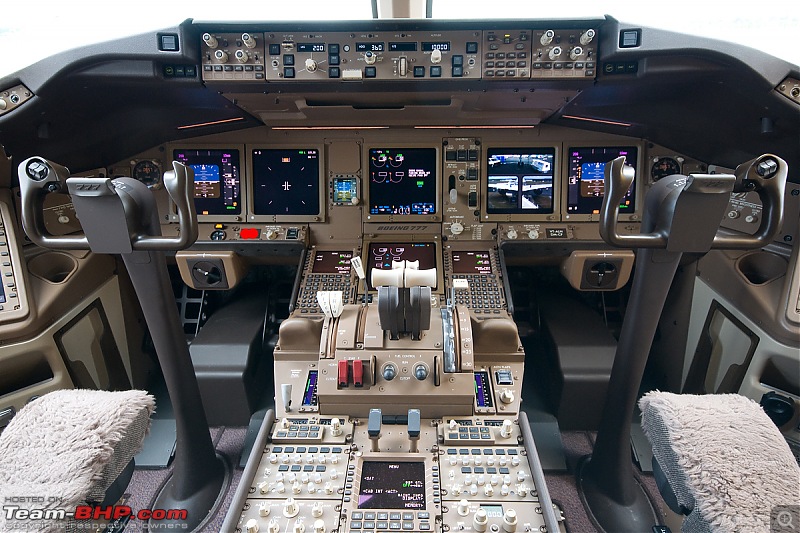
The layout of the cockpit is explained in the image below.

The two main displays in front of the pilot are the PFD (primary flight display; left) and ND (navigational display; right). The pilot and copilot each have a set, and there is a pair of shared DUs (display units) in the center (arranged top-and-bottom).
The information shown on the PFD is explained in the picture below.
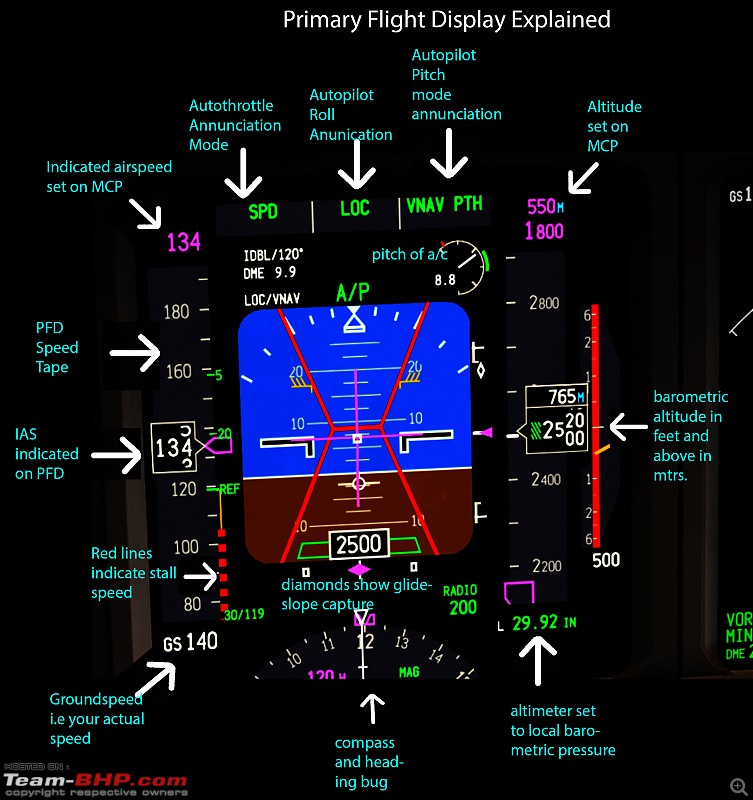
The Boeing 777 has a ground maneuvering camera system (GMCS). It provides pilots with real-time views of the landing gear, ground conditions and proximity to the pavement edge during taxi maneuvers using cameras mounted behind the nose gear and in both leading edges of the horizontal stabilizer. The images appear on a three-way, split screen, flight deck video display.
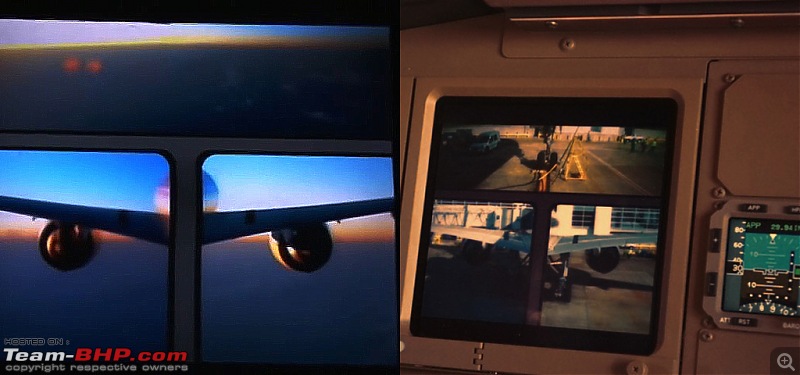

The MFD(Multifunction display) in the Boeing 777 allows us to request data using SATCOM. This data is directly displayed onto the MFD and can also be printed on paper using a small printer.
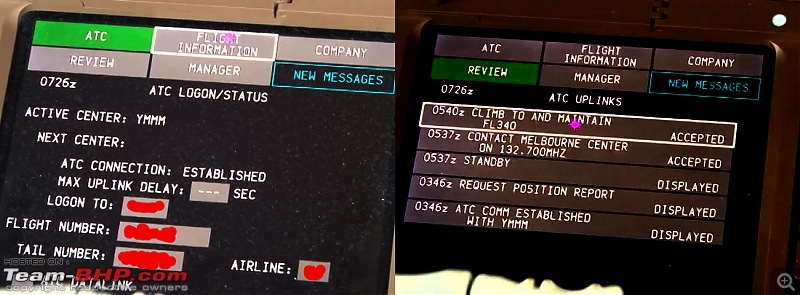
The other use of the MFD is for ECHKL i.e the electronic checklist. This is one thing that I really like on the 777. No more hassles of paper etc. Also, the software automatically checks off items which have been completed. For e.g if I have already pulled up the gear and then open the after takeoff checklist, the GEAR UP item will already be ticked. Here it is in action. Sorry for the really bad quality of pictures here.
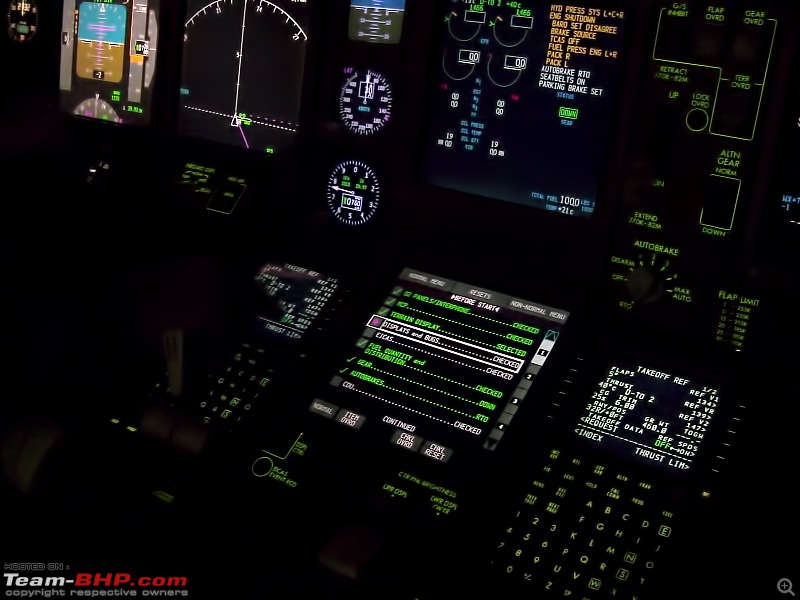
The 757 was infamous for having 31 dimmer switches to lower the lights in the cockpit. On the 777, everything is well thought out, including the single knob to reduce the cockpit lighting level. The MASTER BRIGHT switch also visible.

Shown here are the switches for the heater and display brightness adjustment.

The Autopilot/AFDS of the 777 is a delight to use and deserves an exclusive post. I will be going into the details here, so please feel free to ask questions.
Autopilot Flight Director System
The AFDS consists of three autopilot flight director computers (AFDCs) and the Mode control Panel. The MCP provides control of the autopilot, flight director, altitude alert, and autothrottle systems. The MCP is used to select and activate AFDS modes, and establish altitudes, speeds, and climb/descent profiles.
The MCP looks like this.

Don't get confused by looking at it. Yes, there are a lot of buttons. But I will explain the function of each & every one below.
- LNAV
As the name suggests, LNAV provides lateral guidance to the aircraft. It's all transparent to the pilot, as he enters his route as specified in the clearance and flight plan into the FMS (Flight Management System). The route shows up as a magenta line on the lower flight display, and as long as the autopilot is engaged in the LNAV mode, it will follow that line across the ground. LNAV however does not tell the plane what altitude to fly. - TRK HOLD/SEL & HDG HOLD/SEL
HOLD button will cause the plane to keep it’s heading (or track). Pressing SEL allows you to select the heading – the plane will turn to the heading dialed on the screen above. The important difference between HOLD and SEL is in how the plane behaves when heading selector knob is being turned. In HOLD mode – it will hold your heading. In SEL mode – it will turn as you turn the knob. - LOC
lateral mode used for flying localizer and ILS approaches.
- VNAV
Vertical navigation. Similar to the LNAV – it’s fully automated mode that follows altitude profile programmed in FMC. Additionally – it takes over the autothrottle and controls your speed. VNAV is activated at 400 ft over terrain (or more). On the ground, it's only armed. When you are in VNAV – the AP will climb and descent according to altitudes programmed in FMC but you have to “allow” for the climb or descent by setting the altitude on MCP and pushing the selector button. - FLCH
Flight level change. As the name suggests – vertical mode allowing for changes in altitude while keeping the speed of the aircraft constant at the set value. This is the most used mode while adjusting altitude during cruise. - VS/FPA
Vertical speed modes. The plane will keep selected vertical speed or flight path angle. - Altitude Hold
Press it and the plane will hold it’s current altitude. Really simple. - APP
APP – activates LOC as lateral mode and intercepts glide slope (G/S) of ILS approach.
This is a photo of the FMC(Flight Management computer). This is the brain of the aircraft and tells the autopilot where to go, how to go, how fast to go, and what altitude to go at. When LNAV and VNAV are active, the FMC provides the data to the AFDS. Note that the MCP is the higher authority in case of a conflict. For eg. at DTY waypoint, the forecasted altitude is FL195. But let's say that ATC has cleared you only upto 15000 ft. So you will enter 15000 ft into the altitude window on the MCP. The 777 CAN NOT and WILL NOT cross 15000 ft(i.e the altitude dialled in the MCP).
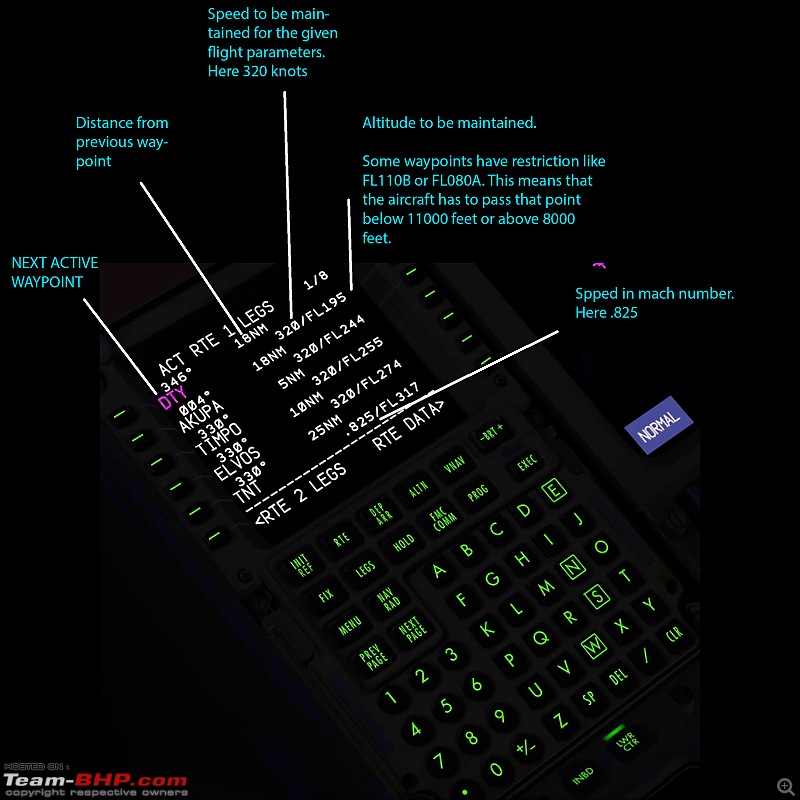
This is the EFIS(electronic flight instrument system) control panel. It is also visible at the extreme left of the MCP photo. In simple terms, the controls on this panel select display range and mode (for example, map or compass rose) and enter data (such as selected heading). It also has 2 additional knobs. The left one sets the minimums altitude(height) callout. This is the height at which the we must have adequate visual reference to the landing environment (i.e. approach or runway lighting) to decide whether to continue landing; or go around. The right one sets the barometric pressure for the baro altimeter. The buttons at the bottom are for displaying/hiding specific details for eg. Airports/Weather/Terrain/Stations/Position etc.
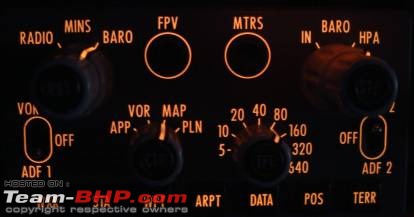 The Autopilot has to control three parameters to fly the plane. Its speed(throttle), its bank angle & its pitch. The roll(bank angle) is controlled by LNAV or HDG/TRK Hold/Select or LOC mode. The pitch is controlled using VNAV, FLCH, V/S, HOLD, or APP mode. The autothrottle modes can be any of the following
The Autopilot has to control three parameters to fly the plane. Its speed(throttle), its bank angle & its pitch. The roll(bank angle) is controlled by LNAV or HDG/TRK Hold/Select or LOC mode. The pitch is controlled using VNAV, FLCH, V/S, HOLD, or APP mode. The autothrottle modes can be any of the following
•
THR – The autothrottle applies thrust to maintain the vertical speed required by the pitch mode.
•
THR REF – Thrust is set to the selected thrust limit displayed on EICAS.
•
IDLE – Displayed while the autothrottle moves the thrust levers to idle; IDLE mode is followed by HOLD mode.
•
HOLD – The thrust lever autothrottle servos are inhibited. The pilot can set the thrust levers manually.
•
SPD – The autothrottle maintains the selected speed displayed on the PFD. Speed can be set by the MCP IAS/MACH selector or by the FMC, as shown on the FMC. The autothrottle will not exceed the operating speed limits or the thrust limits displayed on the EICAS.
----------------------------------------------------------------------------------------------------------------------------------------------------------------------------------------------------
Two important points: What does armed/active mean?
When the mode is armed – it will activate automatically when certain conditions are met. Usually when the plane is in such position that the armed mode can take over. Armed mode is indicated by white text on primary flight display. Active mode is indicated by green text.
This figure illustrates the difference between armed & active.
 Difference between heading and Track
Difference between heading and Track
Heading is where the nose of the aircraft points, while track is the ACTUAL path traveled over ground - just like a set of tracks I would leave behind in the snow or sand, relative to North.
Passenger's view of the 777
Now, I haven't travelled as a passenger in a 777 for an extended period of time. So I am not going to review this section personally. Keep in mind also that the experience, even on the same aircraft, can differ wildly by operator.
The general seat configurations are 3-4-3 in the economy/coach class, 2-3-2 in business and 2-2 in first class. From a global perspective, the 10-abreast cabin in economy class does appear to be a growing trend, especially among European and Middle Eastern carriers. To my surprise, Qatar Airways has also started to introduce the 10-abreast cabin. The legroom varies from operator to operator, from airplane to airplane and even from seat to seat on the same airplane. They range from 31 to 34 inches in the coach or economy section. On American Airlines Boeing 777 planes crossing the Atlantic, most of the cabin seat have 34 inches of legroom but the seat in the middle cabin have only 33 inches. However, British Airways and Continental have a leg room of 31 inches. Delta, 31-33 inches and United Airlines with 31-32 inches.
Safety Record & Incidents
The 777 is one of the safest airplanes in the world. It has had a total of 5 hull loss crashes. And at least two of those three fatal crashes had nothing to do with the airplane itself.
- MS667: Fire due to electrical fault or short circuit resulted in electrical heating of flexible hoses in the flight crew oxygen system. 0 fatalities.
- BAW38: Ice crystals from the fuel system clogging the fuel-oil heat exchanger. 0 fatalities. Heat exchanger was redesigned.
- Asiana 214: Attributed by a National Transportation Safety Board investigation to poor airmanship by the crew. 3 fatalities.
- MH17: The Malaysia Airlines MH17 shootdown was an act of war unrelated to the plane’s performance. 298 fatalities.
- MH370: The disappearance of MH370 in March with 239 people, is still unresolved, but may have been due to pilot suicide or hijacking. The possibility of a malfunction has not been ruled out, which would make it the only 777 fatal accident caused directly by a fault with the airplane.
Comparison with other aircrafts & the future for Boeing 777
If the 777 story tells us anything, it's that the guy with the biggest twin jet wins. The 777's range, reliability and fuel efficiency have made it a popular choice for international routes. But the Boeing 777-300ER and 200LR are now 20 years old and will have to be replaced by the 777X by 2020.
For now, the A350-1000 is head-to-head with the 777-300ER, as the following picture shows. [Last line is cost/seat/mile]. The problem however is that the A350-1000 will be delivered by 2020, by which time the 777X will be here. Then, the A350-1000 will compete with the 777X and will find it very difficult to hold its own.
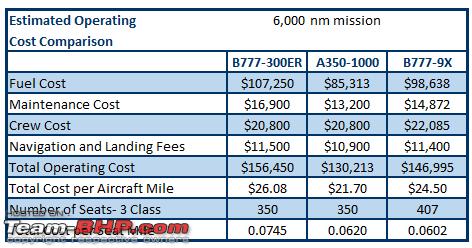
There is another problem as well. For the 777X, Boeing had to meet the specifications of the big gulf carriers. These carriers needed a plane with a big wing and very powerful engines in order to take off fully loaded during the summer. By adhering to these criteria, Boeing secured 235 orders for the 777X from these three carriers, mainly for the larger 777-9 variant. However, the 777X's big wing and powerful engines add weight, which hurts its fuel efficiency on shorter flights.
Airbus has an edge with fuel efficiency since it is lighter, but it loses out in capacity to the 777-9X. If Airbus optimizes a stretched A350 for the European carriers, it will get the capacity but sacrifice the range. The problem is that most airlines want to simplify their fleets. The A350-8000(stretched version of A350-1000 having same capacity as the 777X). would be able to cover most long-haul airline routes, but most airlines do operate some flights beyond its likely range. If they need the 777-9's range for some routes, they might be willing to sacrifice some fuel efficiency rather than buying two planes in the same size segment.
777/A350 vs the double deckers
If there is one thing that these twin jets have surely done, it's sounding the death knell of the quad-jets. The 747 was the queen of the skies for a very long time. As the world's first wide-body airliner, the Boeing 747 went on to change not only aviation but the entire tourism industry. But today, the industry has moved toward twin-engine planes such as the Boeing 777 and the Airbus A330. The 747 is essentially a dead man walking at this point. There comes a time when you have to decide between turning the page & closing the book. For the 747, if not for the A380, the time has probably come. Sad, though. It was the first aircraft that I really loved from the bottom my heart.
The A380 has been a huge disappointment for Airbus so far. Like Boeing bet on the 747 in the 1970's, Airbus bet hugely on one aircraft, i.e the A380 - and lost. Sales, though initially strong, have slowed down in recent years. So far this year, Airbus has sold a grand total of zero A380s. And in spite of denials from the European manufacturer's top brass, speculation continues to mount about whether it can continue to produce this giant of the skies.
The following table from Leeham Co., an aviation consultancy shows how the 7779X fares against the big birds. And no prizes for guessing who comes out smiling.

DISCLAIMER: The information in this review is provided “AS IS” with no warranties, and confers no rights. While every caution has been taken to provide my readers with most accurate information and honest analysis, please use your discretion before taking any decisions based on the information in this review. This review does not represent the thoughts, intentions, plans or strategies of my employer. I do not own any stocks in any of the companies mentioned above and do not intend to influence your decisions. It is solely my opinion. Feel free to challenge me, disagree with me, or tell me I’m completely nuts.
IMAGE SOURCES: Most of the images are my own. The rest of the shots(for eg. the introductory one) are taken from the Boeing company. Any other source than that is mentioned explicitly. Image have been edited wherever required to hide my operator name or the aircraft registration number.
Thread moved out from the Assembly Line! Rating review a full 5 stars :thumbs up
Thanks searchingheaven for the informative post. Also, more thanks for the format of the thread (separate posts for each section without overloading each section).
To summarize, Boeing's acquisition cost is higher compared to Airbus but the running costs are much lower.
The TCO approach means Boeing will win consistently.
Surprised to see this as Indian aerospace has so many Airbus aircrafts. Maybe, in the single aisle segment, Airbus is more economical. Also, as India has an ecosystem of Airbus, the MRO network is more established leading to the preference to Airbus.
Have been an ardent fan of the 777-300ER ever since my first flight on one, aboard Singapore Airlines' flight to Singapore from Mumbai. This is the Rolls Royce (or Bentley if you prefer that) of airplanes, having killed the A340 family (which Airbus discontinued post the rise in oil prices in 2008/09) and also Boeing's own B747.
While the A380 holds the distinction for the largest plane, the 777 has the most powerful engines ever built. I look forward to flights on the 777, and have actually booked tickets on airlines which fly this over the 747 / A330 given the superior comfort levels.
Singapore Airlines has arguably the most comfortable configurations, with a 3-3-3 set-up in Economy for it's trans-Atlantic flights (to San Francisco) which leads to an extremely comfortable cabin with good legroom and seat width. Was also lucky enough to fly on SQ's business product from Singapore - San Francisco, with a 1-2-1 set-up. No other airline has such a spacious and lavish layout.
My most recent flight was aboard Turkish Airlines brand new 777-300ER to Istanbul, which was also excellent. I'm not a fan of Emirates' cattle-class layout of 3-4-3 in economy which is pretty tight seating and constant elbow-clashing with your neighbour.
Can't wait to see what Boeing does with the 777X! I also flew Air India's 787-900 a few months back, which is also an excellent product and due to the carbon fibre fuselage, the airline is able to maintain higher humidity levels in the cabin which leads to less exhaustion after a long flight.
Wow what a treasure trove of information!! Finished the thread completely. Great attention to detail sir. Finally I know (somewhat) what all those buttons do in the cockpit.
Quote:
Originally Posted by turbospooler
(Post 3972778)
Surprised to see this as Indian aerospace has so many Airbus aircrafts. Maybe, in the single aisle segment, Airbus is more economical. Also, as India has an ecosystem of Airbus, the MRO network is more established leading to the preference to Airbus.
|
I think in the single aisle segment, the A320 (especially the new generation A320neo) is much more efficient than the Boeing 737 family. If memory serves me right, I believe the A320 family can also seat more passengers in the A321 variant than the 737-900 can. Airbus also came out with the A320neo much before Boeing introduced its 737NG, capturing the market away from Boeing. It's still a closely fought battle though.
In the Indian context, I believe Jet's fleet is majority 737s, which Indigo exclusively flies the A320. Air India is partial to the Airbus family as well.
I have done only one international travel and that had me travelling from BLR to LHR in a BA 747 and then from LHR to ATL in a BA777.
While I loved the 747 (who wouldnt?) I was impressed by the 777 as a economy passenger. Starting with the 3-4-3 config vs the 3-3-3. And also the interiors were so much better, not just in age but in design. Later came back and read up all about the 777. That engine is just so impressive!
Thank you for such an informative post! :)
| All times are GMT +5.5. The time now is 08:57. | |























